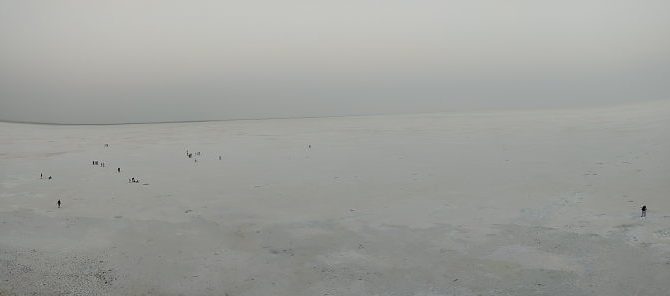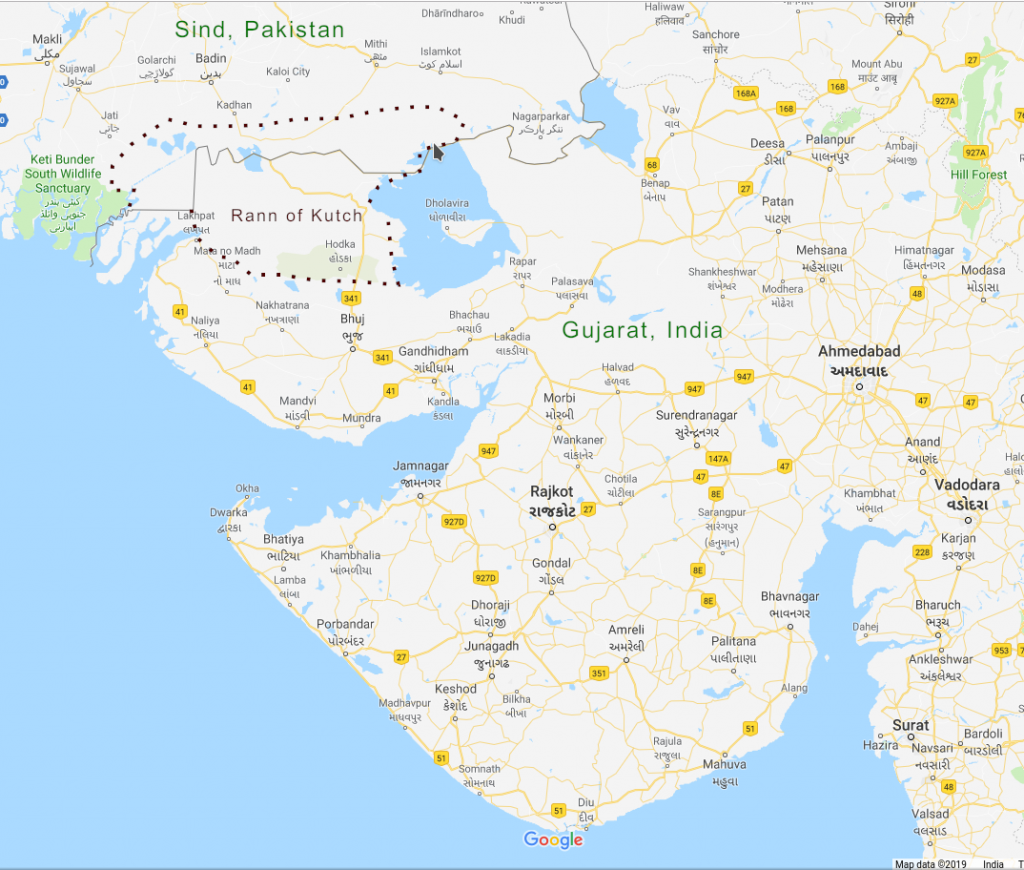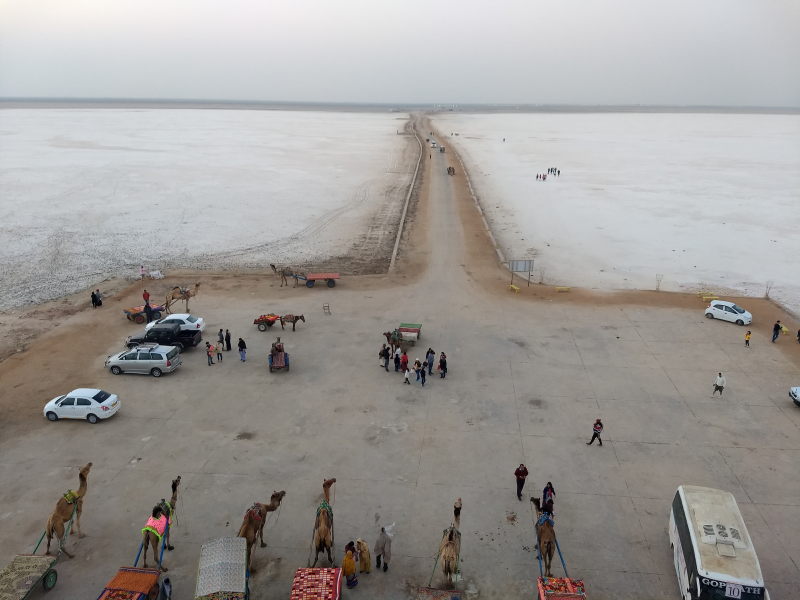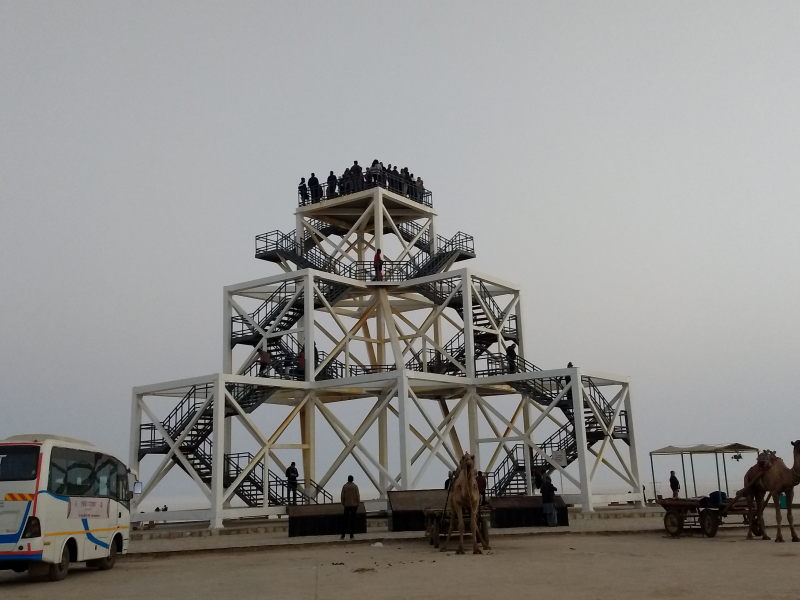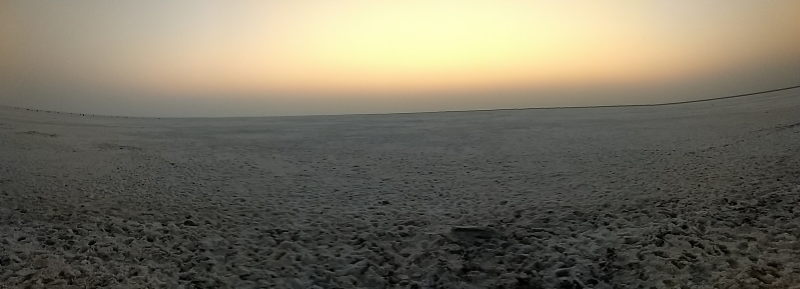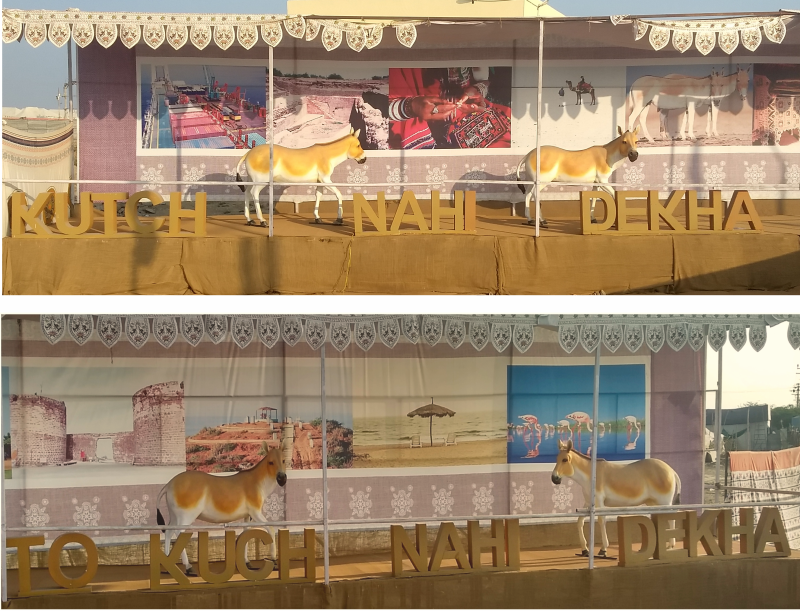You are standing in the middle of an area from where all you can see is white colour. The ground is covered in a powdery white substance that looks crystalline on closer inspection. There aren’t many people around. There isn’t any vegetation around. Nothing grows here because the soil is covered and perhaps its nutrients compromised by the white substance. In your mind, you may conclude that this white substance is snow and that you are standing in the Himalayas.
Here are some problems with that assumption. You are at sea level. You needn’t wear any thermal underwear, gloves or scarves. Sure, at night and early in the morning, this place is cold, but you won’t get a frostbite if you leave your skin exposed. You can pick up the white crystalline substance with your hands and it doesn’t feel freezing. Come afternoon and the heat is sweltering here. You are actually in the middle of a desert covered in salt. You are standing at the Great White desert of Kutch, also known as the Rann of Kutch.
What is Rann of Kutch?
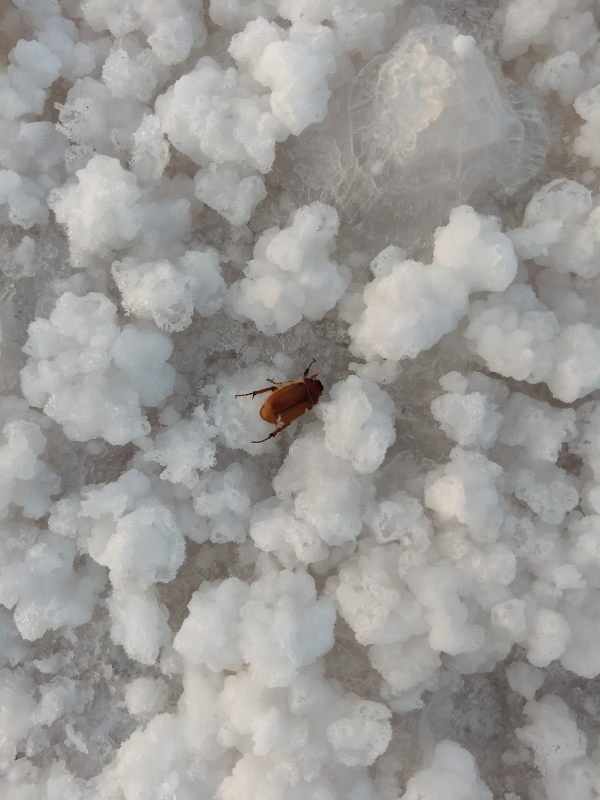
Salt crystals covering the ground at Rann of Kutch. This is what makes the entire desert appear white in colour. Only insects can survive such a desolate surrounding with no vegetation.
In Kutchi language, the word Rann, with its pronunciation matching the English word ‘run’, means a desert. Rann of Kutch covers an area of 7500 sq km in Gujarat state, bordering Sind region of Pakistan. The area under Rann of Kutch was initally abundant in water. The Indus river used to flow into the Arabian sea in this area. Due to an earthquake in the 19th century, the river changed its course. The saline water formed by the creek at the river mouth was left behind. The extreme heat in the region, coupled by no more fresh water supply caused all the water to evaporate and leave behind crystals of salt. As a result, we see a vast area covered by white crystals of salt. Since the salt has compromised the nutrients in the soil, no vegetation grows here. No water, no vegetation. Hence the region is classified as a desert that is white in colour. This is a natural occurence unique to Gujarat and Sind.
Where is Rann of Kutch?
Rann of Kutch is in the north-western corner of Gujarat. It is inside Kutch or Kachchh district. The international border with Pakistan runs west to east across the Rann and splits it into two parts. 1/3rd of the Rann to the north of the border belongs to Pakistan while 2/3rds to the south of the border belongs to India.
To the west of the Rann is the Narayan Sarovar wildlife sanctuary, centred around Narayan Sarovar lake. To the east of the Rann is a huge saline lake, which is a part of the creek still in the process of evaporation. This is the Rann of Kutch lake. To the south of the lake are the rural and urban areas that form the plains of Kutch district. Bhuj, the headquarters of Kutch district, is 80 km to the south of Rann.
To the east of the Rann of Kutch lake, there is another white desert called the Little Rann of Kutch. This place is less touristy, but also looks less spectacular compared to the Great Rann.
If you want to visit all of Gujarat state, including Kutch district’s Gandhidham, Bhuj and Mandvi beach, then you can read the post, How we covered it: Gujarat
What to see at Rann of Kutch
The entrance to Rann of Kutch is near a village named Dhordo. This is the only entry for civilians. The highway from Bhuj to Rann ends at a gate guarded by the Indian Army. After this gate, the road proceeds two kilometres to a dead-end that ends with the whiteness of the desert. To get past this gate, the army requires that you furnish your Aadhar number (Indians) or passport number (foreign nationals).
The road beyond the gate ends at a concrete square known as the Rann viewpoint. At the Rann viewpoint, there is a stilted tower that climbs 3 storeys to give you a spectacular view of the desert.
One can walk upto 500 metres away from the concrete square into the desert. No one would stop you if you were to go further, but common sense says that you’d get lost. The desert is a monotonous stretch of white with no vegetation, hills, man-made or geographical features. Everything looks the same. An expanse of white that stretches upto the horizon. So don’t try to be a superhero, believing that you have exceptional navigation and survival skills.
Sunrise and sunset
It is best to time your visit to the Rann during sunrise or sunset. The golden hues of the sun blend well with the white canvas of the desert. We would recommend watching the sunrise rather than the sunset. Since the authorities need to close the gate before it gets very dark, you won’t be allowed to stay for very long once the sun goes down. It isn’t safe either. But at sunrise, you are under no such pressure since it is only going to get brighter. You can linger in the desert for a bit longer until the heat forces you out of the area.
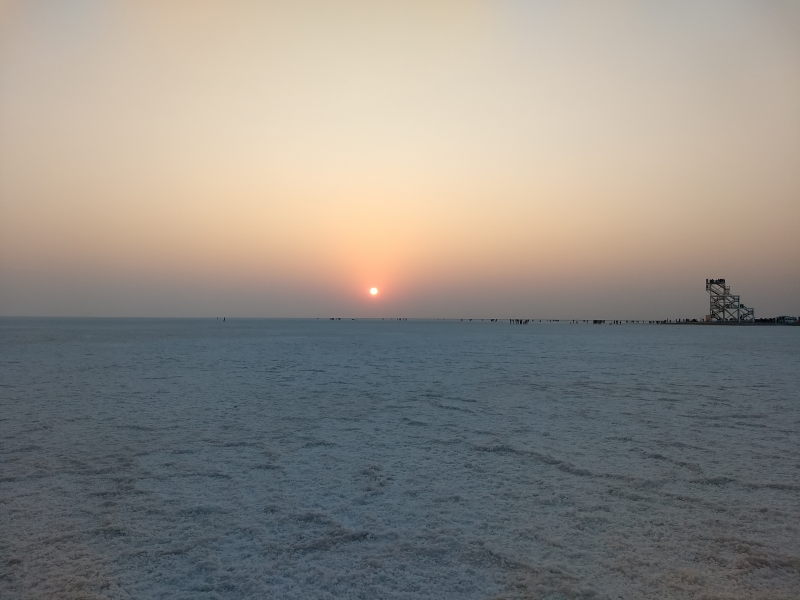
Sun up and running at Rann of Kutch. We have wandered a safe distance from the view tower for this photo, mainly to avoid too many people.
Rann of Kutch festival
Between November and January, a cultural festival happens at the entrance of the Rann at Dhordo. Several local folk music artistes are invited to perform at a stage set up in the area. The performances happen even late at night. During this time, Dhordo village sets up tents for tourists and vendors. You can book an accommodation in one of the tents. Around the residential tents are commercial tents for food vendors and the like.
Be warned that the tented accommodation is exorbitant, given the facilities provided. If you are budget-conscious backpackers / road-trippers like we are, then such accommodation makes no sense monetarily. We didn’t carry our tent during our Gujarat trip, so we do not know if pitching your own tent is allowed in this area. Our view is that Rann of Kutch is too close to Indo-Pak border and has had issues with refugees in the past. Authorities may not take kindly to you setting up camp in such sensitive areas. We found it more economical to stay in or around Bhuj. Since we took our own car to Gujarat, it was easy for us to set off for Rann as early as we could. If you are relying on public transport and want to be around Rann for sunrise / sunset, then staying in Dhordo’s tented accommodation is your best option.
Best season to visit
Rann of Kutch is incredibly hot during summers, which starts in March and continues upto September. Monsoon, which turns the mountains and the fertile plains of the rest of the country lush green, has no effect in Kutch district. Interior Gujarat is dry throughout the year. Day time temperatures can soar to 50 degrees celsius. Even in winters, the dryness of the air can make the day temperature more difficult to tolerate than in humid regions.
We visited Rann of Kutch in January and would recommend that you visit between November to February. Also, try not to be inside the desert after 10 am. The best timings are in the mornings between 5 am – 8 am and evenings between 4 pm to 7 pm. Winter sunset time is around 7 pm and summer sunset can be as late as 8 pm.
Getting there
By air
The closest airport is at Bhuj, the headquarters of Kutch district. Another important airport is at Gandhidham, the commercial hub of the district. However, there are frequent flights to the two cities only from Mumbai. If you are travelling from any other city, then Ahmedabad and Rajkot are better options. From Ahmedabad or Rajkot, you can take buses to Bhuj and then a taxi to Rann.
By rail
Bhuj’s railway station is New Bhuj Jn. It comes under Western Railway and lies on the Ahmedabad – Viramgam – Gandhidham – New Bhuj route. Direct trains to New Bhuj run from Mumbai (3 trains), Pune, Kolkata and Bareilly. Most of them pass through Ahmedabad. If you cannot get a ticket for a direct train to Bhuj, you can book a train to Ahmedabad or Rajkot and then take a bus.
By road public transport
Gujarat state buses run from Ahmedabad, Rajkot, Gandhidham, Palanpur and Jamnagar. From Bhuj, you can hire a taxi to Dhordo.
By driving yourself
To drive to Bhuj, you should first join the NH-8 Mumbai – Surat – Vadodara – Ahmedabad – Udaipur – Jaipur – New Delhi highway. If you are driving from the south of India (e.g. Bengaluru or Chennai), you can join the NH-8 by driving to Pune and then taking the Pune – Lonavla – Navi Mumbai (satellite city to Mumbai) – Thane (also a satellite city) – Vasai bypass. With this, you will skip all of Mumbai city’s traffic. You should exit the higway and enter Ahmedabad city. If you are driving from central India (e.g. Bhopal, Nagpur or Indore), there is a direct highway from Indore to Ahmedabad without using NH-8.
Once at Ahmedabad, you should take the Ahmedabad – Viramgam – Bhachau – Bhuj highway. At the entrance of Bhuj, you will be welcomed by a traffic island with an optical illusion exhibit. A faucet seems to hang in the air and spew water from no visible source. Thereafter, a north-bound highway from Bhuj, in excellent condition, allows you to drive the 80 km from Bhuj to Rann in one hour. At a highway junction at Bhirandiara village, turning left takes you to Rann, while keeping straight takes you to an army check post about 60 km from the Indo-Pak border.
Conclusion
India has plenty of places where nature has played a magical hand in shaping jaw-dropping wonders. Rann of Kutch is one such wonder, where it is amazing to see vast stretches of a salt desert all the way to the horizon. Rann of Kutch is one of a kind.

